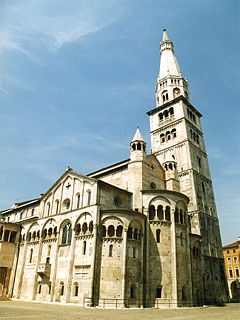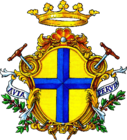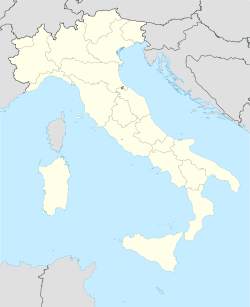Modena
Comune di Modena |
|
|---|---|
 Municipal coat of arms |
|
 |
|
| Country | |
| Region | Emilia-Romagna |
| Province | Modena (MO) |
| Mayor | Giorgio Pighi |
| Elevation | 34 m (112 ft) |
| Area | 182.74 km² (70.6 sq mi) |
| Population (as of 2007-12-31[1]) | |
| - Total | 179,937 |
| - Density | 985/km² (2,551/sq mi) |
| Time zone | CET, UTC+1 |
| Coordinates | |
| Gentilic | Modenesi |
| Dialing code | 059 |
| Postal code | 41100 |
| Frazioni | Albareto, Baggiovara, Ca' Fusara, Cognento, Cittanova, Collegara, Ganaceto, Lesignana, Marzaglia, Navicello, Portile, San Damaso, San Donnino, Tre Olmi, Villanova |
| Patron | San Geminiano |
| - Day | January 31 |
| Website: www.comune.modena.it | |
Modena (IPA: [ˈmɔːdena]; Mòdna in Modenese dialect) is a city and a comune (municipality) on the south side of the Po valley, in the Province of Modena in the Emilia-Romagna region of Italy.
An ancient town, it is the seat of an archbishop, but is now best known as "the capital of engines", since the factories of the famous Italian sports car makers Ferrari, De Tomaso, Lamborghini, Pagani and Maserati are, or were, located here and all, except Lamborghini, have headquarters in the city or nearby. Lamborghini is headquartered not far away in Sant'Agata Bolognese, in the adjacent Province of Bologna.
The University of Modena, founded in 1175 and expanded by Francesco II d'Este in 1686, has traditional strengths in Economics, Medicine and Law. Italian officers are trained at the Italian Military Academy, located in Modena, and partly housed in the Baroque ducal palace. The Biblioteca Estense houses historical volumes and 3,000 manuscripts.
Modena is well known in culinary circles for its production of balsamic vinegar.
Famous Modenesi include Mary of Modena, the Queen consort of England; operatic tenor Luciano Pavarotti (1935-2007) and soprano Mirella Freni , born in Modena itself; the Catholic Priest and Senior Exorcist of Vatican Gabriele Amorth; and the rock singer Vasco Rossi who was born in Zocca, one of the 47 comuni in the Province of Modena.
Contents |
Geography
Modena lies on the Pianura Padana, and is bounded by the two rivers Secchia and Panaro, both affluents of the Po River. Their presence is symbolized by the Two Rivers Fountain in the city's center, by Giuseppe Graziosi. The city is connected to the Panaro by the Naviglio channel.
The Apennines ranges begin some 10 km from the city, to the south.
The commune is divided into four circoscrizioni. These are:
- Centro storico (Historical Center, San Cataldo)
- Crocetta (San Lazzaro-East Modena, Crocetta)
- Buon Pastore (Buon Pastore, Sant'Agnese, San Damaso)
- San Faustino (S.Faustino-Saliceta San Giuliano, Madonnina-Quattro Ville)
Under the Köppen climate classification Modena is usually classified as having a Humid subtropical climate (Cfa). It experiences hot, humid summers with little rainfall and cold, damp winters.
History
Ancient times
The territory around Modena (Roman Mutina, Etruscan Muoina) was inhabited by the Villanovans in the Iron Age, and later by Ligurian tribes, Etruscans, and the Gaulish Boii (the settlement itself being Etruscan). Although the exact date of its foundation is unknown, it is known that it was already in existence in the 3rd century BC, for in 218 BC, during Hannibal's invasion of Italy, the Boii revolted and laid siege to the city. Livy described it as a fortified citadel where Roman magistrates took shelter. The outcome of the siege is not known, but the city was most likely abandoned after Hannibal's arrival. Mutina was refounded as a Roman colony in 183 BC, to be used as a military base by Marcus Aemilius Lepidus, causing the Ligurians to sack it in 177 BC. Nonetheless, it was rebuilt, and quickly became the most important centre in Cisalpine Gaul, both because of its strategic importance and because it was on an important crossroads between Via Aemilia and the road going to Verona.

In the 1st century BC Mutina was besieged twice. The first siege was by Pompey in 78 BC, when Mutina was defended by Marcus Junius Brutus (a populist leader, not to be confused with his son, Caesar's most well known assassin). The city eventually surrendered out of hunger, and Brutus fled, only to be slain in Regium Lepidi. In the following civil war after Caesar's assassination the city was besieged once again, this time by Mark Antony, in 44 BC, and defended by Decimus Junius Brutus. Octavian relieved the city with the help of the Senate.
Cicero defined it Mutina splendidissima ("most beautiful Mutina") in his Philippics (44 BC). Until the 3rd century AD it kept its position as the most important city in the newly formed Aemilia, but the fall of the Empire brought Mutina down with it, as it was used as a military base both against the barbarians and in the civil wars. It is said that Mutina was never sacked by Attila, for a dense fog hid it (a miracle said to be provided by Saint Geminianus, bishop and patron of Modena), but it was eventually buried by a great flood in the 7th century and abandoned.
Middle Ages
Its exiles founded a new city a few miles to the northwest, still represented by the village of Cittanova (literally "new city"). About the end of the 9th century, Modena was restored and refortified by its bishop, Ludovicus. At about this time the Song of the Watchmen of Modena was composed. Later the city was part of the possessions of the Countess Matilda of Tuscany, becoming a free commune starting from the 12th century. In the wars between Emperor Frederick II and Pope Gregory IX Modena sided with the emperor.
The Este family were identified as lords of Modena from 1288 (Obizzo d'Este). After the death of Obizzo's successor (Azzo VIII, in 1308) the commune reasserted itself, but by 1336 the Este family was permanently in power. Under Borso d'Este Modena was made a duchy.
Modern age
Enlarged and fortified by Ercole II, it was made the primary ducal residence when Ferrara, the main Este seat, fell to the Pope in 1598. Francesco I d'Este (1629-1658) built the citadel and began the palace, which was largely embellished by Francesco II. In the 18th century, Rinaldo d'Este was twice driven from his city by French invasions, and Francesco III built many of Modena's public buildings, but the Este pictures were sold and many of them wound up in Dresden. Ercole III died in exile at Treviso, having refused Napoleonic offers of compensation when Modena was made part of the Napoleonic Cispadane Republic. His only daughter, Maria Beatrice d'Este, married Ferdinand of Austria, son of Maria Theresa, and in 1814 their eldest son, Francesco IV, received back the estates of the Este. Quickly, in 1816, he dismantled the fortifications that might well have been used against him and began Modena's years under Austrian rule, reactionary and despotic, using the Austrian army to put down a rebellion in 1830. His equally reactionary son, Francesco V, was temporarily expelled from Modena in the European Revolution of 1848, but was restored by Austrian troops. Ten years later, on August 20, 1859, the representatives of Modena declared their territory part of the Kingdom of Italy, a decision that was confirmed by the plebiscite of 1860.




Main sights
The Cathedral and the Ghirlandina
The Cathedral of Modena and the annexed campanile are a UNESCO World Heritage Site. Begun under the direction of the Countess Matilda of Tuscany with its first stone laid June 6, 1099 and its crypt ready for the city's patron, Saint Geminianus, and consecrated only six years later, the Duomo of Modena was finished in 1184. The building of a great cathedral in this flood-prone ravaged former center of Arianism was an act of urban renewal in itself, and an expression of the flood of piety that motivated the contemporary First Crusade. Unusually, the master builder's name, Lanfranco, was celebrated in his own day: the city's chronicler expressed the popular confidence in the master-mason from Como, Lanfranco: by God's mercy the man was found (inventus est vir). The sculptor Wiligelmus who directed the mason's yard was praised in the plaque that commemorated the founding. The program of the sculpture is not lost in a welter of detail: the wild dangerous universe of the exterior is mediated by the Biblical figures of the portals leading to the Christian world of the interior. In Wiligelmus' sculpture at Modena, the human body takes on a renewed physicality it had lost in the schematic symbolic figures of previous centuries. At the east end, three apses reflect the division of the body of the cathedral into nave and wide aisles with their bold, solid masses. Modena's Duomo inspired campaigns of cathedral and abbey building in emulation through the valley of the Po.
The Gothic campanile (1224-1319) is called Torre della Ghirlandina from the bronze garland surrounding the weathercock.
Ducal Palace
The Ducal Palace, begun by Francesco I d'Este in 1634 and finished by Francis V, was the seat of the Este court from the 17-19th century. The palace occupies the site of the former Este Castle, once located in the periphery of the city. Although generally credited to Bartolomeo Avanzini, it has been suggested that advice and guidance in the design process had been sought from the contemporary luminaries, Cortona, Bernini, and Borromini.
The Palace currently houses the Accademia Militare di Modena, the Military Museum and a precious Library.
The Palace has a Baroque façade from which the Honour Court, where the military ceremonies are held, and the Honour Staircase can be accessed. The Central Hall has a frescoed ceiling with the 17th century Incoronation of Bradamante by Marco Antonio Franceschini. The Salottino d'Oro ("Golden Hall"), covered with gilted removable panels, was used by Duke Francis III as his main cabinet of work.
Town Hall
Facing the Piazza Grande (a UNESCO World Heritage Site), the Town Hall of Modena was put together in the 17th-18th centuries from several pre-existing edifices built from 1046 as municipal offices.
It is characterized by a Clock Tower (Torre dell'Orologio, late 15th century), once paired with another tower (Torre Civica) demolished after an earthquake in 1671. In the interior, noteworthy is the Sala del Fuoco ("Fire Hall"), with a painted frieze by Niccolò dell'Abate (1546) portraying famous characters from Ancient Rome against a typical Emilia background. The Camerino dei Confirmati ("Chamber of the Confirmed") houses one of the symbols of the city, the Secchia Rapita, a bucket kept in memory of the victorious Battle of Zappolino (1325) against Bologna. This relic inspired the poem of the same title by Alessandro Tassoni. Another relic from the Middle Ages in Modena is the Preda Ringadora, a rectangular marble stone next to the palace porch, used as a speakers' platform, and the statue called La Bonissima ("The Very Good"): the latter, portraying a female figure, was erected in the square in 1268 and later installed over the porch.
Museum Palace
The Palace Museum, on the St. Augustine square, is an example of civil architecture from the Este period, built as a Hostel for the Poor together with the nearby Hospital in the late 18th century. Today it houses the main museums of Modena:
- Estense Gallery, with works by Tintoretto, Paolo Veronese, Guido Reni, Correggio, Cosmé Tura and the Carracci brothers. The most famous works are the two portraits of Francis I d'Este, a sculpture by Gian Lorenzo Bernini and a canvas by Diego Velazquez.
- Estense Library, one of the most important libraries in Italy.
- Museum of Mediaeval and Modern Art.
- Municipal Museum of Risorgimento.
- Este Headstones Museum.
- Graziosi Chalks Gallery.
- Archaeological and Ethnological Museum.
Other churches
- San Vincenzo was erected in the 17th century over a church known from the 13th century. The works were begun by Paolo Reggiano, who was followed by Bernardo Castagnini, probably helped by the young Guarino Guarini. The interior contains frescoes by Sigismondo Caula portraying episodes of the life of Saint Vincent and Saint Cajetan. The dome was destroyed during World War II. This church houses the funerary monuments of the Este Dukes.
- Santa Maria della Pomposa (also known as Aedes Muratoriana) is probably the most ancient religious edifice, being mentioned as early as 1135. Little remains of the original Middle Ages temple can be seen. The church is mainly linked to Ludovico Antonio Muratori, who was its parish priest from 1716 to 1750 and rebuilt it almost from scratch.
- The church of San Giovanni Decollato ("St. John Baptist Beheaded") was built in the 16th century over a pre-existing temple dedicated to St. Michael, and modified in the 18th century.
- The church of St. Augustine was built in the 14th century, but largely renovated for the funerals of Alfonso IV d'Este in 1663. The sober original structure has now 17th stuccoes and a panelled ceiling. The most notable artwork is the Deposition (1476) by the Modenese Antonio Begarelli, once in the church of St. John the Baptist. Traces of a 14th century fresco by Tommaso da Modena can still be seen.
- The church of St. Francis was built by the Franciscans from 1244, and finished after more than two centuries. A sober Gothic-style edifice, it houses one of Begarelli's masterworks, a Deposition of Christ made up of thirteen statues.
- The church of St. Peter was erected, according to tradition, over the temple of Jupiter Capitulinus. The current edifice is from 1476, built next to a Benedictine abbey founded in 996 oustide the city walls, and is one of the few Renaissance architecture in Modena. The interior has a precious 15th century organ and numerous terracotta works by Begarelli. The campanile is from 1629.
- The church of St. George is also known as the Sanctuary of the Blessed Virgin Helper of the Modenese People, who boasts a venerated image over the high altar. The latter is a work in polychrome marbles by Antonio Loraghi (1666). The church has a Greek plan and was constructed from 1647.
Synagogue
- The Synagogue, next to the Palazzo Comunale, was built from 1873 by the Jewish Community of Modena in Lombardesque style.
Other points of interest
- Orto Botanico dell'Università di Modena e Reggio Emilia, a botanical garden
Culture
Teatro Comunale Modena
- See Teatro Comunale Modena, Modena's opera house which dates from 1841, for full article
Demographics
In 2007, there were 179,937 people residing in Modena located in the province of Modena, Emilia-Romagna, of whom 48.1% were male and 51.9% were female. Minors (children ages 18 and younger) totalled 16.20 percent of the population compared to pensioners who number 22.54 percent. This compares with the Italian average of 18.06 percent (minors) and 19.94 percent (pensioners). The average age of Modena resident is 44 compared to the Italian average of 42. In the five years between 2002 and 2007, the population of Modena experienced 2.42% growth, while Italy as a whole grew by 3.56 percent.[1][2] The current birth rate of Modena is 9.62 births per 1,000 inhabitants compared to the Italian average of 9.45 births.
As of 2006, 89.61% of the population was Italian. The largest foreign group cam from other parts of Europe (namely Romania and Albania): 3.94%, followed by North Africa: 2.40%, and sub-saharan Africa: 1.94%. Approximately 1 in 5 newborns in Modena has a least one parent of foreign origins.[3]
Sport
Modena has a strong sporting tradition, linked mainly to motor racing as the birthplace of Enzo Ferrari, founder of the eponymous motor racing team and car manufacturer which is based in nearby Maranello. The Ferrari 360 Modena was named after the city. Indeed, Modena is known as the World's 'Supercar Capital', being the nearest large town to the homes of Maserati, Lamborghini, Pagani and previously also Bugatti and De Tomaso. The city's football club, Modena F.C., plays in Serie B, the Italian second division. Volleyball plays an important role in Modena's sport history, with Panini Modena club having won 11 National championships, 4 Champion's League seasons and a handful of other trophies.
Twinnings
See also
- Duchy of Modena and Reggio
- List of Dukes of Modena
External links
- Official website of the Modena Tourist Information Office - in English
- Teatro Communale information from the Modena website
- Introduction to Modena cathedral, illustrated
- Description of the cathedral
- Modena Photo Gallery Pictures of Modena
- Meteo Modena Weather cam located in Modena (Italian)
- Webcam Modena Street webcam located Via Sauro, downtown Modena
|
|||||||||||||||
|
|||||||
